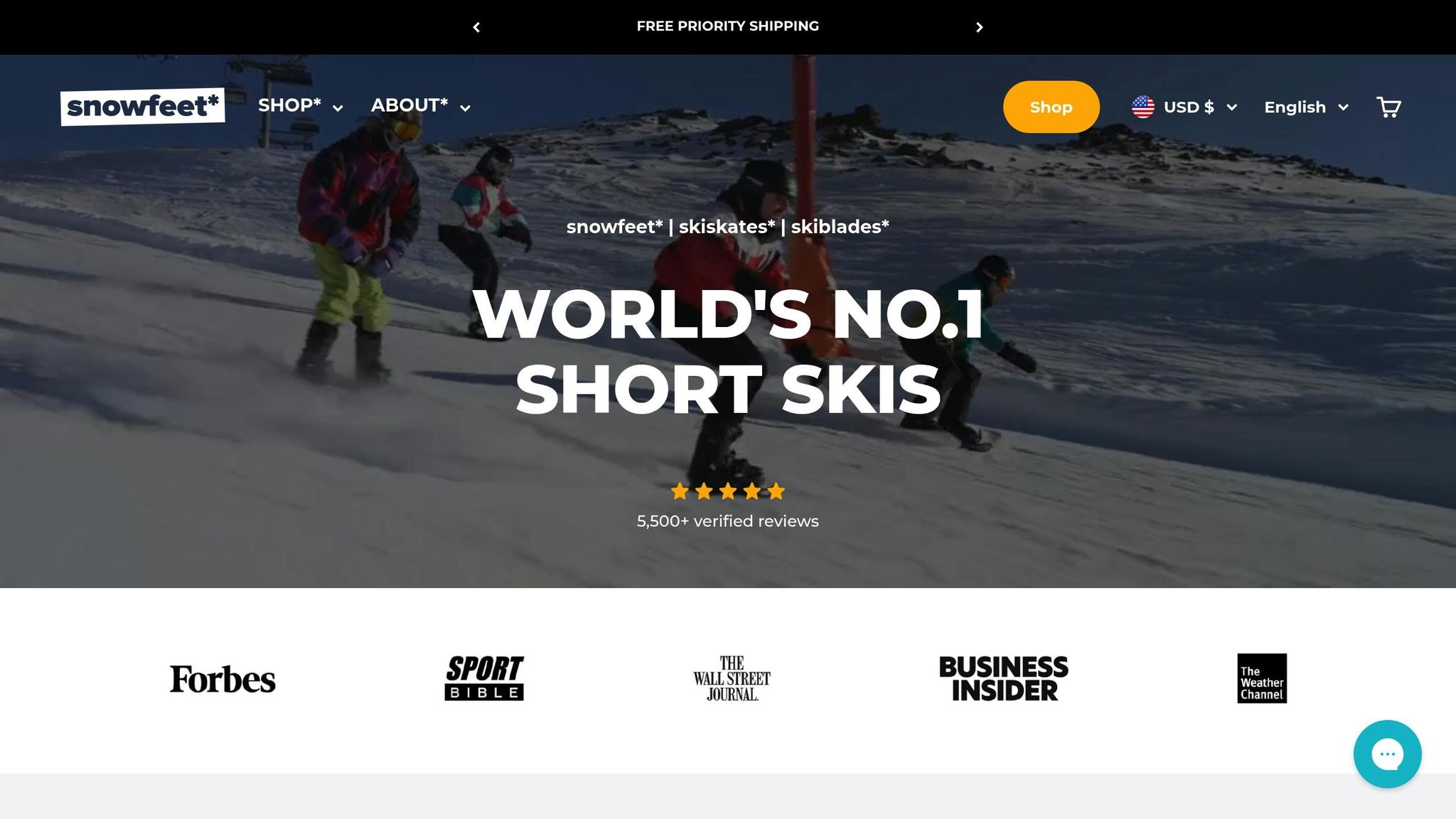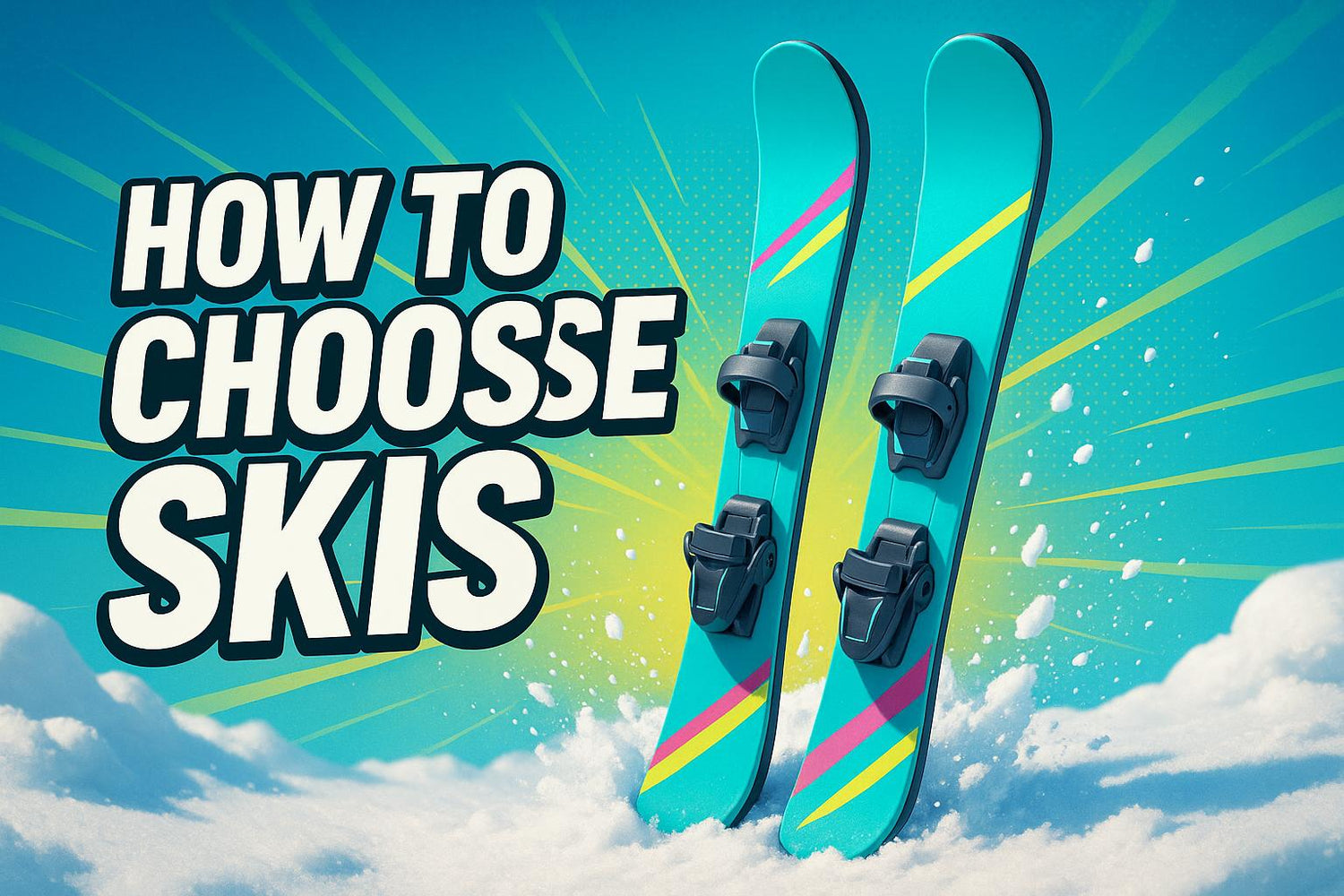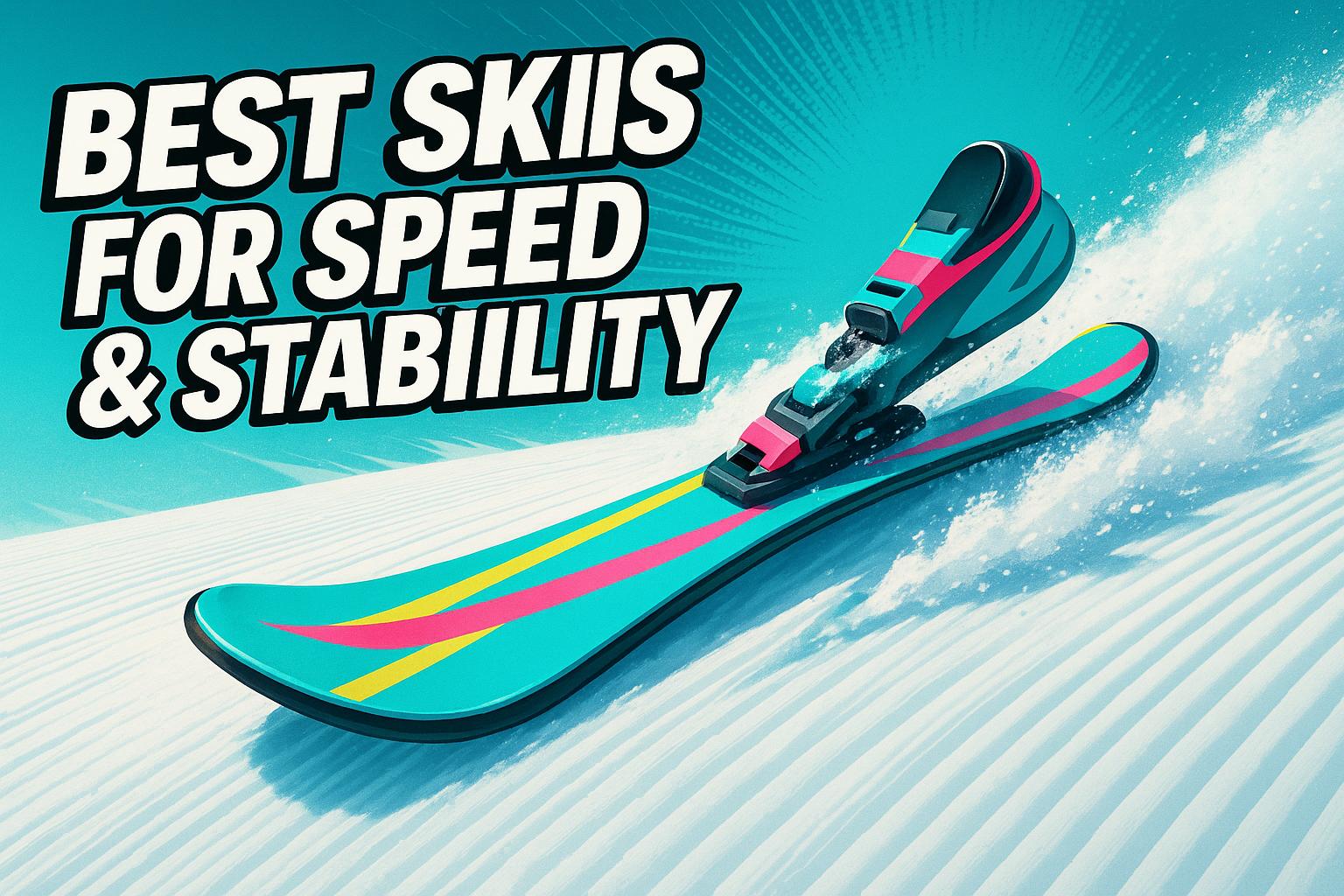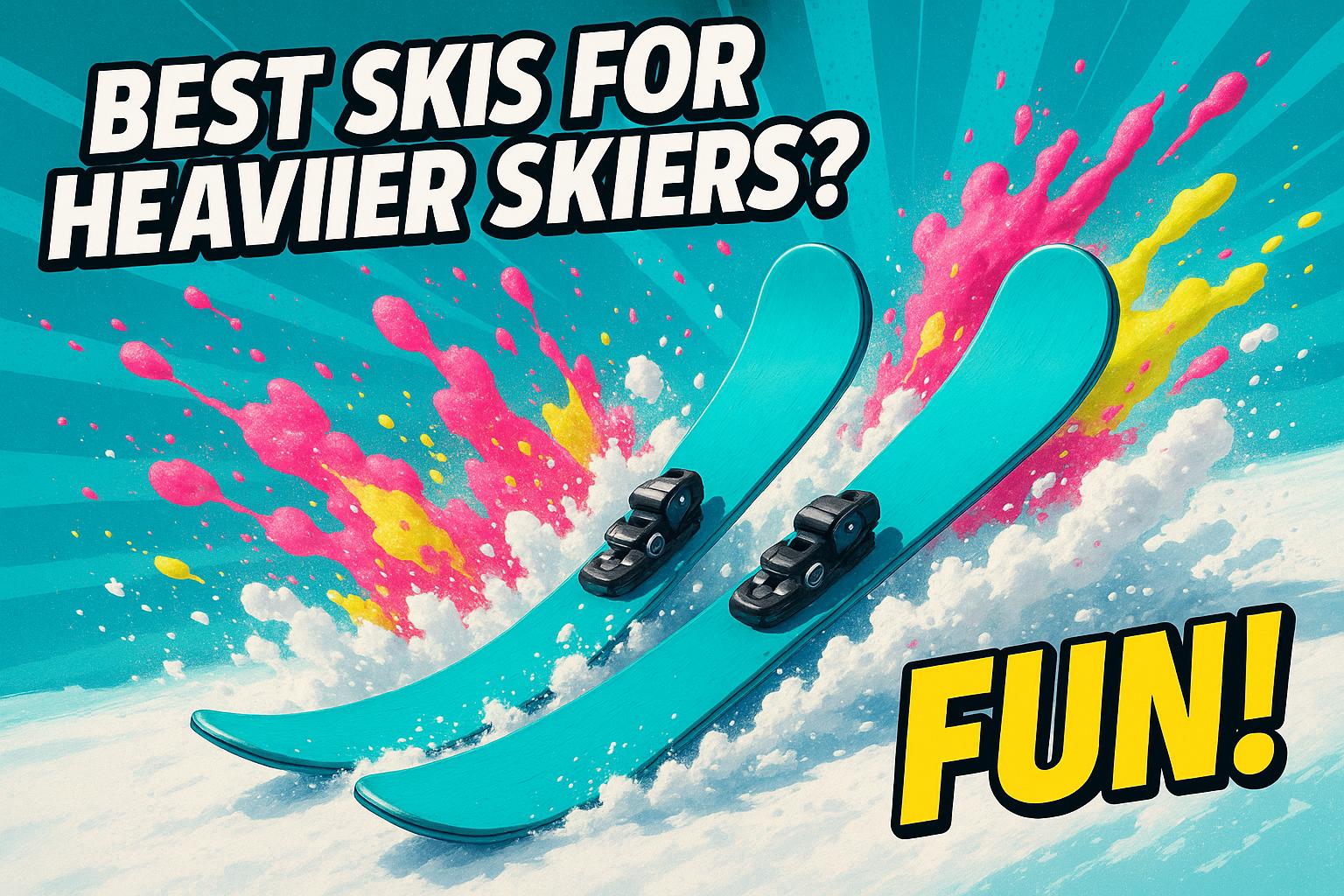Stel je voor dat je een helling afskiet en elke hobbel en trilling voelt - dat is vermoeiend, toch? Daar komen dempende en stabiele ski's om de hoek kijken. Ze absorberen schokken, verminderen getril en houden je in controle, zelfs op ijzige of oneffen ondergrond. Het resultaat? Een soepelere rit, minder vermoeidheid en meer vertrouwen om van je afdalingen te genieten.
Hier komt het verrassende deel: kortere ski's, zoals die van Snowfeet*, kunnen dezelfde soepele, stabiele ervaring bieden zonder het volume of de steile leercurve van langere ski's. Ze zijn makkelijker te hanteren, draagbaar en werken zelfs met gewone winterlaarzen - geen dure, gespecialiseerde uitrusting nodig.
Belangrijkste punten:
- Dempen: Neemt trillingen op voor een soepelere rit.
- Stabiliteit: Houdt je in controle, zelfs bij lagere snelheden of op lastig terrein.
- Waarom Korte Ski's? Het compacte ontwerp vermindert trillingen en verbetert de handling zonder in te leveren op stabiliteit.
Als je op zoek bent naar een ski-setup die soepel, gemakkelijk te beheersen is en perfect voor alle vaardigheidsniveaus, dan kunnen Snowfeet* korte ski's wel eens de gamechanger zijn die je nodig hebt.
Hoe Kies Je Ski's: Ski Maat, Soorten Ski's & Meer
Wat "Demping" en "Stabiliteit" Betekenen bij het Skiën
Als het om skiën gaat, komen twee termen vaak naar voren: demping en stabiliteit. Dit zijn sleutelbegrippen die bepalen hoe ski's trillingen verwerken en op koers blijven. Kortom, ze spelen een grote rol in hoe soepel en gecontroleerd je rit aanvoelt op de piste.
Wat Demping Betekent bij Ski's
Demping gaat helemaal over het vermogen van een ski om trillingen op te nemen en de boel stabiel te houden wanneer je ruw of ijzig terrein raakt. Zie het als de schokdempers in je auto - ze zorgen ervoor dat je de hobbels niet elke keer voelt.
Op harde sneeuw of ijzige plekken kunnen traditionele lange ski's van merken zoals Völkl, Blizzard of Head veel trillingen rechtstreeks naar je skischoenen sturen. Dit kan leiden tot "chatter", dat trillende, oscillerende gevoel dat je vertrouwen kan ondermijnen. Een ski met goede demping absorbeert deze trillingen voordat ze jou bereiken, wat zorgt voor een soepelere, beter gecontroleerde ervaring en helpt vermoeidheid tijdens langere skisessies te verminderen.
Snowfeet*, met hun korte ski-ontwerp, tillen demping naar een hoger niveau. Hun compacte bouw (variërend van 44 cm tot 120 cm vergeleken met traditionele ski's van 170–180 cm) beperkt trillingen natuurlijk. Minder oppervlakte betekent minder oscillaties, wat ervaren skiërs een soepelere, beter gecontroleerde rit geeft. De kortere lengte en lagere zwaartepunt werken samen om zowel demping als algehele stabiliteit te verbeteren.
Terwijl demping de rit soepel houdt door trillingen te verminderen, zorgt stabiliteit ervoor dat je de controle behoudt - beide zijn cruciaal voor een geweldige dag op de berg.
Wat Stabiliteit Betekent bij Ski's
Stabiliteit draait daarentegen helemaal om controle. Het gaat erom hoe goed een ski ongewenste bewegingen weerstaat, zoals zijwaarts wiebelen of plotselinge richtingsveranderingen. Een stabiele ski blijft op koers en houdt zijn kant vast tijdens bochten, zodat jij je kunt concentreren op je afdaling in plaats van te vechten tegen je uitrusting.
Er bestaat een algemeen geloof dat langere ski's automatisch stabieler zijn. Hoewel ze bij hoge snelheden goed kunnen sturen, vereisen ze ook meer kracht en verfijnde techniek, vooral als je door nauwe ruimtes navigeert of op lagere snelheden skiet.
Echte stabiliteit gaat niet alleen over lengte - het gaat erom hoe voorspelbaar en betrouwbaar een ski aanvoelt onder verschillende omstandigheden en snelheden. Een stabiele ski reageert op je bewegingen zonder verrassingen, zodat je niet constant kleine aanpassingen hoeft te maken tijdens het skiën.
Snowfeet* ski's hanteren een slimme benadering van stabiliteit. In plaats van te vertrouwen op lengte, vermindert hun kortere ontwerp de traagheid, waardoor het makkelijker wordt om van richting te veranderen met minder inspanning. Dit betekent dat je snelle, responsieve besturing krijgt die natuurlijk en zelfverzekerd aanvoelt, of je nu je eerste bocht maakt of een lange dag op de piste afsluit.
Waarom Snowfeet* Korte Ski's Betere Demping en Stabiliteit Bieden

Als het gaat om demping en stabiliteit, leveren Snowfeet* korte ski's een niveau van controle en soepelheid dat traditionele lange ski's gewoon niet kunnen evenaren. Hun slimme ontwerp daagt het lang bestaande idee uit dat langere ski's automatisch een betere rit bieden.
Hoe Korte Ski's Stabiliteit en Demping Verbeteren
Het geheim achter de prestaties van Snowfeet* ligt in de natuurkunde. Kortere ski's hebben minder oppervlakte, wat betekent dat er minder mogelijkheden zijn voor trillingen om zich te manifesteren. Traditionele ski's van merken zoals Rossignol of K2 variëren doorgaans van 67 tot 79 inch (170–200 cm) in lengte, wat meer contactpunten creëert die trillingen kunnen versterken. Daarentegen meten Snowfeet* Skiblades slechts 26 tot 47 inch, wat het contactoppervlak aanzienlijk vermindert. Dit zorgt voor preciezere besturing en dempt trillingen, wat je een soepelere rit geeft.
Bovendien speelt hun constructie een grote rol. Snowfeet* Skiblades hebben een houten kern gecombineerd met precieze metalen kanten en een versterkte kap. Dit ontwerp vermindert niet alleen trillingen, maar verhoogt ook de responsiviteit, vooral op ijzige of hard gepakte sneeuw. De versterkte kapconstructie vermindert ongewenste flexibiliteit en traagheid, waardoor bochten moeiteloos aanvoelen vergeleken met de zwaardere, langere traditionele ski's.
En het gaat niet alleen om de specificaties - gebruikers melden consequent dat Snowfeet* producten makkelijker zijn om op te leren en veel minder vermoeiend dan traditionele ski's. Ze omschrijven de ervaring als speels en vergelijkbaar met rolschaatsen, met uitstekende controle en stabiliteit. Studies bevestigen dit, en tonen aan dat het lichtere, responsievere ontwerp helpt vermoeidheid te verminderen, zelfs na een hele dag op de piste.
Draagbaarheid en Gemakkelijk Gebruik van Snowfeet* Producten
De voordelen stoppen niet bij de prestaties. Het lichte en compacte ontwerp van Snowfeet* producten maakt ze ongelooflijk praktisch voor dagelijks gebruik. In tegenstelling tot traditionele ski's, die vaak dakdragers of omvangrijke opslagoplossingen vereisen, passen Snowfeet* Skiblades en Skiskates gemakkelijk in standaard bagage. Dit maakt ze eenvoudig mee te nemen, in te pakken en te vervoeren.
Nog een groot pluspunt? Snowfeet* producten zijn ontworpen om te werken met gewone winter- of snowboardboots, zodat je de kosten van speciale skischoenen kunt overslaan, die tussen de $200 en $600 kunnen kosten. Ze hebben zelfs verstelbare snowboardbindingen ontwikkeld die zorgen voor een veilige, antislip pasvorm, wat zowel stabiliteit als comfort toevoegt.
Met hun vermogen om soepelere ritten, betere controle en ongeëvenaarde gemak te combineren, biedt Snowfeet* een modern alternatief voor het volume en gedoe van traditionele ski-uitrusting. Wie wil dat nou niet?
Snowfeet* Short Skis vs Traditionele ski's en Snowboards
Jarenlang heeft de wintersportindustrie vastgehouden aan het idee 'groter is beter', vooral als het gaat om ski's en snowboards. Maar Snowfeet* short skis keren dat idee om. Deze compacte ski's bieden een verrassende wending aan stabiliteit en controle, en dagen de langdurige dominantie van traditionele lange ski's en snowboards uit. Laten we het eens nader bekijken.
De waarheid over lange ski's en stabiliteit
Veel skiërs denken dat langere ski's meer stabiliteit betekenen. Merken zoals Salomon, Atomic en Volkl hebben hun reputaties opgebouwd met ski's van 67 tot 79 inch (170-200 cm), die goed presteren in diepe POWDER of bij hoge snelheden. Maar hier is de catch: langere ski's kunnen trillingen juist versterken. Het grotere oppervlak betekent meer contact met de sneeuw, wat kan leiden tot getril en instabiliteit, vooral op ijzige of harde ondergrond.
Snowfeet* short skis nemen een andere benadering. Met hun compacte formaat – de Mini Ski Skates meten slechts 15 inch (38 cm) en de Skiskates 17 inch (44 cm) – verminderen ze het contactoppervlak, de flexibiliteit en trillingen. Dit kleinere ontwerp draait niet om het nemen van shortcuts; het gaat om maximale controle. Kortere ski's hebben een lager zwaartepunt en minder traagheid, wat snellere reacties en soepelere bochten betekent. Of je nu over geprepareerde pistes cruiset of onvoorspelbare sneeuw aanpakt, Snowfeet* levert een rit die zowel stabiel als leuk is.
Om te zien hoe ze zich verhouden, bekijk de vergelijkingstabel hieronder.
Vergelijkingstabel: Snowfeet* vs Traditionele ski's en Snowboards
| Kenmerk | Snowfeet* Short Skis | Traditionele ski's | Snowboards |
|---|---|---|---|
| Lengtebereik | 15-47 inch (38-120 cm) | 67-79 inch (170-200 cm) | 59-65 inch (150-165 cm) |
| Gewicht | 2-4 lbs per paar | 8-12 lbs per paar | 6-10 lbs per paar |
| Trillingsdemping | Uitstekend – minimaal contact met oppervlak | Gemiddeld – gevoelig voor trillen | Goed – ontwerp met enkele rand |
| Leercurve | Makkelijk – gevoel als rolschaatsen | Steil – vaak lessen nodig | Gemiddeld – focus op balans |
| Compatibiliteit van laarzen | Werkt met winterschoenen of snowboardlaarzen | Vereist dure skischoenen | Alleen snowboardlaarzen |
| Draagbaarheid | Rugzakvriendelijk | Heeft een dakdrager of skitas nodig | Lomp maar beheersbaar |
| Prijsbereik | $150-$690 | $400-$1,200+ | $300-$800+ |
| Onderhoud | Laag – minimaal onderhoud | Regelmatig onderhoud nodig | Moet gewaxt en geslepen worden |
| Terrein Veelzijdigheid | Pistes, parken, achtertuinen | Voornamelijk skipistes | Voornamelijk skipistes |
Waarom Snowfeet* Opvalt
Als je de totale kosten en het gemak meerekent, komen Snowfeet* short skis als winnaar uit de bus. Traditionele sets van merken als Rossignol of K2 vereisen vaak flinke investeringen in ski's, schoenen, bindingen en stokken, wat gemakkelijk boven de $1.000 uit kan komen. Daarentegen werken Snowfeet* met de winterschoenen die je al hebt, wat het een veel betaalbaardere en toegankelijkere optie maakt.
Bovendien blinken Snowfeet* producten uit in hun veelzijdigheid. Terwijl lange ski's geweldig zijn voor niche-omstandigheden zoals diepe POWDER of hoge snelheden, hebben ze moeite met het soort gemengd terrein waar de meeste recreatieve skiërs mee te maken hebben. Snowfeet* short skis gaan moeiteloos om met geprepareerde pistes, terrain parks en zelfs je met sneeuw bedekte achtertuin.
En laten we de logistieke voordelen niet vergeten. In tegenstelling tot traditionele ski's, die dakdragers of oversized tassen vereisen, passen Snowfeet* netjes in een rugzak of handbagage. Dat betekent geen gedoe meer met lompe uitrusting of stress over opslag. Spontane skitrips? Helemaal haalbaar.
Snowboards zijn weliswaar draagbaarder dan lange ski's, maar vereisen nog steeds speciale schoenen en bindingen. Ze dwingen je ook in een zijwaartse houding, wat niet voor iedereen natuurlijk aanvoelt. Snowfeet* houdt het simpel met een naar voren gerichte ontwerp dat intuïtief aanvoelt, zelfs voor beginners.
Kortom, Snowfeet* short skis herschrijven de regels van wintersport – ze bieden stabiliteit, veelzijdigheid en gebruiksgemak in een compact, leuk pakket.
sbb-itb-17ade95
Hoe Kies Je Het Juiste Snowfeet* Model
Het kiezen van het juiste Snowfeet* model komt neer op het vinden van de perfecte balans tussen stabiliteit en soepelheid voor jouw skistijl. Elk model brengt zijn eigen unieke kenmerken mee, en biedt een leuke en gecontroleerde ervaring die voortbouwt op de kernvoordelen van Snowfeet* short skis.
Snowfeet* Modellen en Hun Kenmerken
Snowfeet Mini Ski Skates (15 in/38 cm)
Vanaf $150 zijn dit de meest compacte optie in de lijn. Ze draaien helemaal om wendbaarheid en zijn een solide keuze voor beginners die de skateslag onder de knie willen krijgen. Hun kleine formaat helpt trillingen te verminderen, wat zorgt voor een soepele rit op geprepareerde pistes.
Skiskates (17 in/44 cm)
Vanaf $390 meten deze 17 inch en zijn ze gebouwd met een houten kern die trillingen absorbeert. Ze bieden een stabiel, skate-achtig gevoel dat perfect is voor rijders die een mix van controle en wendbaarheid willen.
Skiblades (26 in/65 cm)
Voor $450 tillen deze ski's stabiliteit naar een hoger niveau. Met meer oppervlaktecontact bieden ze betere kanten grip en dempen ze trillingen, zelfs op wisselend terrein. Ze zijn een geweldige middenweg voor skiërs die meer controle willen zonder wendbaarheid op te geven.
Skiblades (39 in/99 cm)
Voor $490 bieden deze ski's serieuze stabiliteit terwijl ze korter en makkelijker te hanteren zijn dan traditionele ski's. Ze zorgen voor een soepele, gecontroleerde ervaring die ideaal is voor wie prestaties zoekt die dichter bij standaard ski's liggen. Voor POWDER-liefhebbers voegt de Snowfeet POWDER variant in deze maat extra drijfvermogen toe voor diepere sneeuwcondities.
Snowfeet Short Skis (47 in/120 cm)
Voor $690 is dit het premium model in de Snowfeet* collectie. Deze ski's maximaliseren stabiliteit en soepelheid terwijl ze draagbaar en gemakkelijk te hanteren blijven in vergelijking met gewone lange ski's.
Modellen afstemmen op je skistijl
Je skistijl en vaardigheidsniveau spelen een grote rol bij het kiezen van het juiste model. Als je maximale stabiliteit zoekt, zijn de 99‑cm of 120‑cm modellen je beste keuze. Deze langere ski's werken uitstekend op geprepareerde pistes en bieden meer sneeuwcontact voor soepelere, beter gecontroleerde bochten. Ze zijn ook een goede keuze voor iedereen die overstapt van traditionele ski's.
De 65‑cm Skiblades bieden een mooie balans tussen stabiliteit en wendbaarheid. Ze zijn stabiel genoeg voor diverse terreinen maar kort genoeg om behendig te blijven - perfect voor gevorderde skiërs die hun vaardigheden aanscherpen.
Voor beginners of recreatieve skiërs zijn de Mini Ski Skates of Skiskates ideaal. Bij lagere snelheden zijn ze gemakkelijk te hanteren en bieden ze voldoende stabiliteit voor recreatief skiën, ook al dempen ze trillingen niet zo goed als de langere modellen.
Denk tot slot aan je lichaamsbouw en de typische skiomstandigheden. Als je langer of zwaarder bent, geven de 99‑cm of 120‑cm modellen je de extra stabiliteit die je nodig hebt. Lichtere skiërs kunnen daarentegen uitstekende prestaties ervaren met de kortere modellen zonder controle te verliezen. Voor geprepareerde pistes of matige snelheden zijn de 65‑cm of 99‑cm modellen geweldige allround keuzes.
Tips voor maximale stabiliteit en soepelheid met Snowfeet*
Om de beste prestaties uit je Snowfeet* ski's te halen, is het beheersen van de juiste techniek essentieel. Deze korte ski's zijn ontworpen om direct op je bewegingen te reageren, dus een stevige houding en de juiste vorm zijn je beste vrienden voor een soepele en stabiele rit.
De houding en techniek beheersen
Begin met een ontspannen, atletische houding. Houd je gewicht gecentreerd over je ski's - dit helpt je in balans te blijven en haalt het beste uit het strakke, trillingsreducerende ontwerp van Snowfeet*. Zie je benen als ingebouwde schokdempers. Buig en strek ze om hobbels moeiteloos op te vangen. Houd ook je knieën uit elkaar zodat elk been onafhankelijk kan bewegen. Dit verbetert je vermogen om te kanten, sturen en in balans te blijven. Deze basisprincipes vormen de fundering om je Snowfeet* ski's op hun best te laten presteren.
Bij het overbrengen van kracht, richt je op het strekken vanuit je knieën in plaats van je enkels. Blijf gecentreerd over de bal van je voet om constante druk te behouden, wat zowel controle als stabiliteit verbetert. Houd je schenen altijd in contact met je skischoenen, en rol bij het draaien je schenen om de ski's te sturen. Deze techniek werkt perfect met het responsieve ontwerp van Snowfeet*, waardoor je elke keer dat je de piste op gaat een soepelere, stabielere rit hebt.
Waarom Snowfeet* de beste keuze is voor dempend en stabiel skiën
Snowfeet* heeft het spel volledig veranderd als het gaat om stabiel, soepel skiën. Terwijl grote merken als Rossignol, K2 en Salomon traditioneel het idee promoten dat langere ski's betere prestaties leveren, draait Snowfeet* dat idee om. Hun kortere ski-ontwerpen bieden indrukwekkende stabiliteit en controle, en bewijzen dat minder soms meer kan zijn.
Neem bijvoorbeeld hun assortiment. Van de supercompacte 38cm Mini Ski Skates tot de veelzijdige 120cm Short Skis, elk product in het Snowfeet* assortiment is ontworpen met balans en gebruiksgemak in gedachten. Deze kortere ski's gaan moeiteloos om met lastig terrein, zonder het volume en gedoe van traditionele ski's. Bovendien maakt hun kleinere formaat ze ongelooflijk draagbaar - geen dakdragers of lompe opbergoplossingen nodig. Je kunt ze letterlijk in een rugzak gooien en gaan.
Nog een opvallend kenmerk? Snowfeet* is ongelooflijk gebruiksvriendelijk. In tegenstelling tot traditionele ski's die eeuwen kunnen duren om onder de knie te krijgen, zijn Snowfeet* producten ontworpen voor snel leren. Hun responsieve ontwerp helpt je snel je balans te vinden, waardoor je benen natuurlijke hobbels en ongelijk terrein absorberen. Skiën wordt zo eenvoudig.
En dan is er nog de prijs. Snowfeet* biedt premium stabiliteit en prestaties zonder de bank te breken. Vanaf slechts $150 voor de Mini Ski Skates zijn ze een veel betaalbaardere optie vergeleken met de meeste traditionele ski-sets. Of je nu gaat voor de 44cm Skiskates voor scherpe manoeuvres of de 99cm Skiblades voor veelzijdigheid, Snowfeet* levert professionele prestaties zonder het hoge prijskaartje.
Kort gezegd bewijst Snowfeet* dat kleinere uitrusting grote resultaten kan leveren. Als je op zoek bent naar soepel, stabiel skiën zonder het volume, is Snowfeet* de juiste keuze.
Veelgestelde vragen
Hoe presteren Snowfeet short skis in vergelijking met traditionele ski's op verschillende soorten terrein?
Snowfeet short skis brengen een heel nieuw prestatieniveau vergeleken met traditionele skis, vooral als het gaat om wendbaarheid en controle. Dankzij hun compacte formaat en lichtgewicht constructie zijn deze skis ongelooflijk responsief, waardoor scherpe bochten en het behouden van een stevige rand op harde of ijzige ondergronden een fluitje van een cent zijn. Als je iemand bent die precisie en stabiliteit waardeert in lastige omstandigheden, zijn deze skis een echte game-changer.
Bovendien zijn Snowfeet skis gebouwd om alle soorten terrein aan te kunnen. Of je nu over geprepareerde pistes glijdt of de backcountry POWDER in gaat, hun speelse, wendbare ontwerp maakt elke rit soepel en gecontroleerd. Als je op zoek bent naar een rit die stabiel maar toch levendig aanvoelt, zijn Snowfeet short skis een fantastische alternatief voor traditionele lange skis. Plus, hun draagbaarheid en gebruiksgemak maken ze een no-brainer voor iedereen die hoge prestaties wil zonder het gedoe van zware uitrusting.
Waarom zijn Snowfeet short skis beter voor beginners dan traditionele lange skis?
Snowfeet short skis zijn een uitstekende keuze voor beginners omdat ze licht, compact en super makkelijk te hanteren zijn. Hun kortere lengte, zoals de 44 cm Skiskates of 99 cm Skiblades, maakt balanceren eenvoudiger en neemt een deel van de intimiderende factor weg die bij traditionele lange skis hoort. Zo kunnen beginners zich richten op plezier maken terwijl ze de basis in hun eigen tempo leren.
Een ander groot pluspunt? Hun lichtgewicht, draagbare ontwerp betekent minder vermoeidheid, zodat je meer tijd op de piste kunt doorbrengen zonder uitgeput te raken. In tegenstelling tot traditionele skis die zwaar en lastig te beheersen kunnen aanvoelen, bieden Snowfeet short skis een stabiele en vergevingsgezinde rit, waardoor het voor nieuwkomers makkelijker is om vertrouwen op te bouwen en comfortabel te verbeteren.
Zijn Snowfeet short skis een goede keuze voor ervaren skiërs die stabiliteit en controle willen bij hogere snelheden?
Snowfeet short skis, zoals de 120 cm Skiblades, zijn een uitstekende keuze voor beginnende tot gevorderde skiërs die stabiliteit en controle willen bij matige snelheden. Ze zijn niet gemaakt voor gevorderde rijders die jagen op topsnelheden of messcherpe precisie - die eigenschappen vind je meestal in langere skis van traditionele merken. Maar wat ze missen aan snelheid, maken ze ruimschoots goed door een leuke en wendbare ervaring te bieden.
Voor ervaren skiërs springen Snowfeet skis eruit met hun snelle wendbaarheid en vermogen om scherpe bochten te maken. Ze zijn ideaal voor speelse, dynamische ritten. Dus, als je een ervaren skiër bent die controle waardeert en houdt van een levendig, responsief gevoel boven pure snelheid, dan zijn Snowfeet short skis misschien wel de perfecte aanvulling op je uitrusting.


































Laat een reactie achter
Deze site wordt beschermd door hCaptcha en het privacybeleid en de servicevoorwaarden van hCaptcha zijn van toepassing.